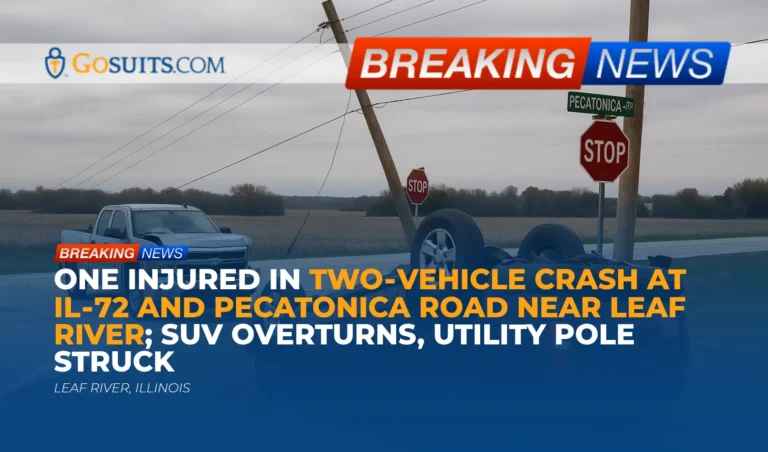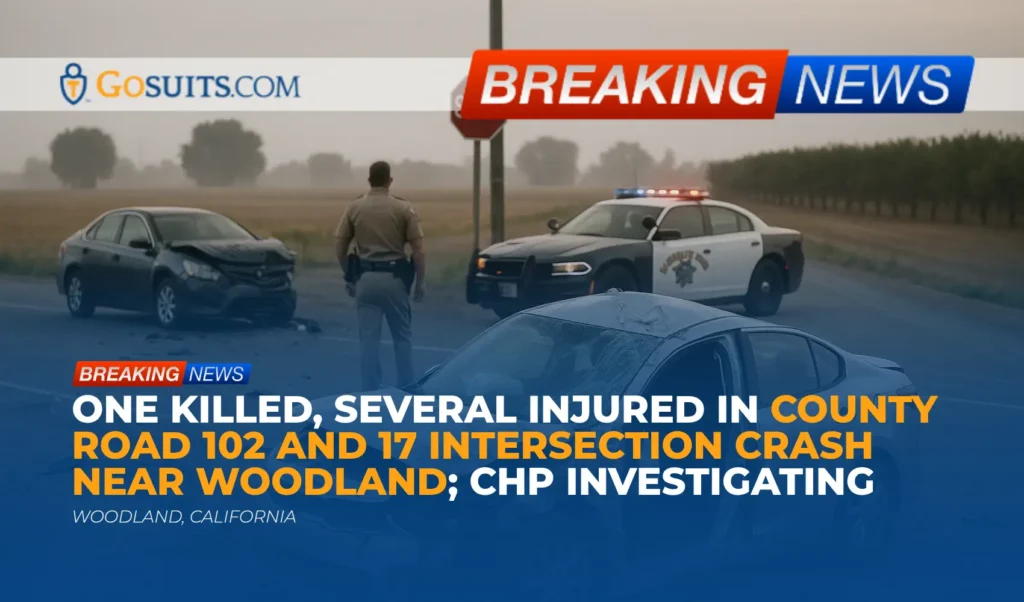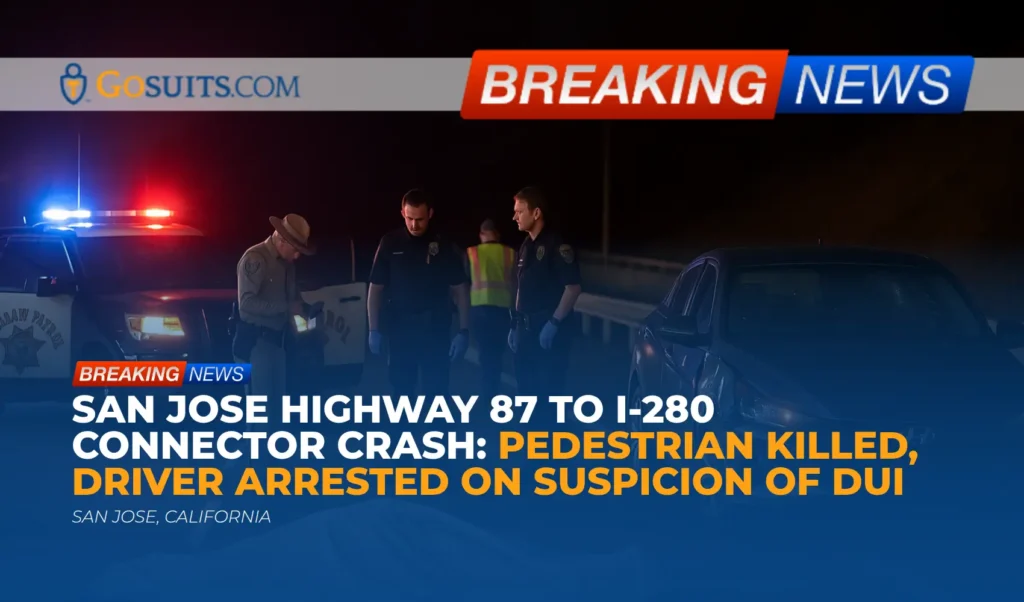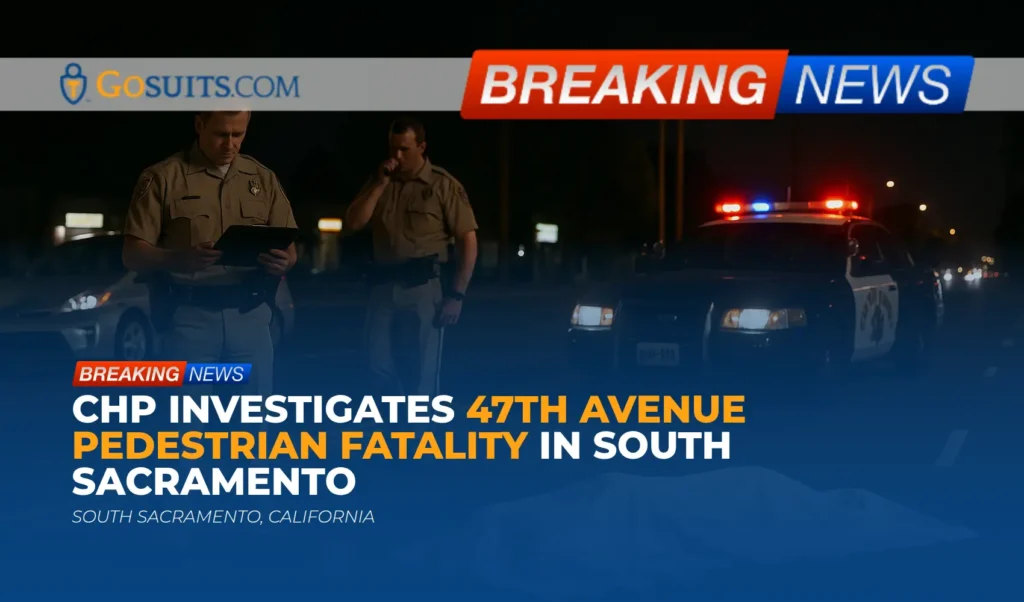- What We Know About the Illinois Route 72 and Pecatonica Road Crash
- Scene Safety Concerns Noted in Public Reports
- How Liability Is Evaluated in Two‑Vehicle Rural Intersection Crashes in Illinois
- Insurance and Financial Considerations After a Crash on a State Route in Illinois
- Practical Steps to Take in the Next 72 Hours
- How to Obtain Official Records and Information
- Deadlines, Comparative Fault, and Preserving Evidence Under Illinois Law
- Common Injuries in Rollovers and Why Early Medical Care Matters
- Data Snapshot: Rural Roadway Intersections and Rollover Risk
- Commentary from Gosuits Leaf River, Illinois Personal Injury Attorney
- Why Acting Promptly Matters After a Serious Crash
- Sources
What We Know About the Illinois Route 72 and Pecatonica Road Crash
Public reports indicate that around noon on Wednesday, October 22, 2025, first responders were dispatched to a two‑vehicle collision at the intersection of Illinois Route 72 and Pecatonica Road near Leaf River in Ogle County, Illinois. The Leaf River Fire Department reported responding to the scene. Photos described in reporting show a Chevrolet Silverado with significant front‑end damage and a red Chevrolet SUV that came to rest overturned. A utility pole also appears to have been struck.
Authorities said one person was transported to a hospital with minor injuries. Around the time of the crash, the Ogle County Sheriff’s Office issued an alert through its public app advising motorists to avoid the area due to a “major accident.” Officials have not yet made public the cause of the crash or whether anyone else was injured. As of the latest update, no additional confirmed facts about fault, citations, or additional injuries have been released.
Because official investigations take time, it is normal for early reports to focus on immediate safety and road closures rather than definitive findings about the cause. In the days ahead, law enforcement and potentially other agencies may release crash reports, diagrams, and other records that clarify what occurred.
Scene Safety Concerns Noted in Public Reports
The combination of an overturned SUV and a damaged power pole highlights several safety hazards that can affect both victims and responders:
- Downed or damaged power lines: When a utility pole is struck, live electrical lines may be involved. Federal preparedness guidance emphasizes staying inside the vehicle if power lines are on it and waiting for utility crews to confirm the scene is safe. Exiting a vehicle that may be energized can be extremely dangerous. See Ready.gov’s safety guidance in the sources below for general best practices regarding downed power lines.
- Vehicle rollover dynamics: An overturned vehicle can hide injuries that are not immediately visible, including head, neck, and internal trauma. Even when someone feels “fine,” medical professionals often recommend evaluation because symptoms can emerge hours or days later, especially after jolting or partial ejection events.
- Secondary collision risk: On two‑lane state routes, stopped traffic and obstructed views can increase the risk of secondary crashes. Law enforcement’s immediate closure notice was aimed at preventing additional harm.
For anyone approaching a similar scene, always follow instructions from law enforcement and fire personnel, avoid the area if asked, and do not touch or approach any downed lines or damaged utility equipment.
How Liability Is Evaluated in Two‑Vehicle Rural Intersection Crashes in Illinois
Assigning civil responsibility after a two‑vehicle crash at a rural intersection typically involves a careful review of facts from several angles. While the cause of this specific collision has not been made public, these are the kinds of questions investigators and insurance adjusters commonly examine:
- Right‑of‑way and traffic controls: What signage or signals control each approach? Were any stop or yield signs present, and were they visible and unobstructed? If there are no signals, investigators often evaluate who entered the intersection first and whether a driver failed to yield the right‑of‑way.
- Speed and sight distances: Rural routes can have higher speed limits with limited sight lines due to terrain, buildings, or vegetation. Skid marks, yaw marks from an overturn, event data recorder (EDR) downloads, and witness statements can help reconstruct speed and braking.
- Lane position and point of impact: Crush patterns, debris fields, and final rest positions help identify where contact occurred. An SUV coming to rest upside down may also reflect lateral forces and vehicle dynamics.
- Utility pole impact: A struck pole may indicate a vehicle left the intended travel path after or during the collision. Photos and utility repair records can corroborate timing and impact forces.
- Visibility and lighting: Weather, sun angle, glare, and roadway lighting conditions are often documented, even for midday crashes.
- Driver condition: Investigators may review whether either driver was fatigued, distracted, or impaired, though such determinations require evidence and are not assumed.
Illinois follows a modified comparative fault rule. If multiple drivers share fault, any recovery can be reduced by a person’s percentage of fault, and recovery is barred if that person is more than 50 percent at fault under state statute. See the sources section for the statutory reference. Because comparative fault can become a central issue, accurate fact gathering early on is important.
Insurance and Financial Considerations After a Crash on a State Route in Illinois
Illinois is an at‑fault auto insurance state. Claims for bodily injury and property damage generally go through the insurer of the driver deemed negligent, subject to comparative fault and coverage limits. Key points for Illinois crashes include:
- Minimum required liability coverage: Illinois requires minimum liability limits of $25,000 for bodily injury to one person, $50,000 per crash if more than one person is injured, and $20,000 for property damage. Uninsured and underinsured motorist coverage is also required at least at the bodily injury minimums. These are minimums; actual policies can be higher.
- Medical payments coverage (MedPay): Some Illinois policies include optional MedPay, which can help with medical bills regardless of fault. Review the policy declarations to confirm whether MedPay applies.
- Health insurance and liens: When health insurance pays crash‑related bills, the insurer or providers may assert reimbursement rights or liens under Illinois law. Managing liens properly is important to avoid surprises at settlement.
- Property damage and total loss: An overturned SUV and a heavily damaged pickup may trigger total loss evaluations. Illinois law on property damage claims differs from bodily injury claims, including longer filing deadlines in some situations.
- Claims involving utility property: If a pole is struck, the utility may assert a claim for its property damage. This does not determine who is at fault for the crash itself, but it is a separate financial exposure that insurers may handle.
Insurance companies typically open liability investigations quickly. Before giving a recorded statement to any insurer, consider speaking with a seasoned attorney. What is said to an insurance adjuster can be used later and may affect fault apportionment and claim value. A free consultation can clarify rights and obligations without committing to any course of action.
Practical Steps to Take in the Next 72 Hours
The first few days after a crash often shape how the claim unfolds. Without speculating about this specific incident, these general steps can help protect safety and documentation:
- Prioritize health: Even with initially minor‑reported injuries, schedule a medical evaluation. Some injuries, including concussions, soft‑tissue trauma, and internal injuries, may not fully present immediately.
- Preserve evidence: Keep photos, video, and contact information for witnesses. If available, download and save dashcam footage now; many devices overwrite within days.
- Secure the vehicles: If a vehicle was towed, note the tow yard location and do not authorize disposal until the claim is resolved. Event data recorder downloads may be important in two‑vehicle collisions.
- Document expenses: Keep all bills and receipts (medical copays, prescriptions, transport, rental car, lost work hours).
- Consult before you call insurers: Consider contacting an attorney for a free consultation before providing recorded statements to any insurer. Early statements can be used later to dispute injuries or fault.
- Follow treating providers’ instructions: Attend follow‑ups and complete prescribed care. Gaps in treatment can be interpreted by insurers as a sign injuries were not serious.
How to Obtain Official Records and Information
Several agencies may hold documents about a crash like the one reported near Leaf River. Availability and timing vary by agency policy and state law.
Law Enforcement Crash Report
The investigating agency appears to be the Ogle County Sheriff’s Office, based on the public alert. To request the official crash report and any associated diagrams or photos:
- Ogle County Sheriff’s Office (Records/FOIA): Visit the official Ogle County government website to locate the Sheriff’s Office records or Freedom of Information Act (FOIA) request portal. Requests typically require date, time, location, and parties if known.
- Illinois FOIA basics: Illinois law allows the public to request non‑exempt records from local government agencies. Some records may be redacted for privacy or investigative reasons, and pending investigations can affect timing.
Motorist Crash Report (if applicable)
Illinois requires a motorist report to the state if a crash results in injury, death, or property damage above a statutory threshold. This is commonly associated with the Illinois Motorist Report process overseen by the Illinois Department of Transportation. Drivers should review IDOT’s guidance to determine whether a report is required and how to submit it within the deadline.
Fire and EMS Run Reports
The Leaf River Fire Department responded. Fire and EMS run reports can sometimes be requested through the department or the local governing body’s records office, subject to privacy laws. These records can confirm response times, observed vehicle positions, and initial patient assessments.

Utility Records
Because a power pole appears to have been struck, the local electric utility may have its own incident and repair records. These can corroborate timeline and damage. Requests typically go through the utility’s customer service or claims department. Avoid direct contact with field equipment; only seek records through official channels.
Medical Records
Patients are entitled to copies of their medical records. Hospital and clinic portals can expedite access to visit summaries, imaging, and bills. Federal regulations give patients the right to access their records; providers may charge reasonable fees for copies but must comply within specified timeframes.
If a Fatality Is Later Reported
At the time of reporting, only minor injuries were publicly noted. If a fatality were later confirmed, the Ogle County Coroner’s Office would ordinarily oversee post‑mortem examinations and issue death certificates. Families can ask the coroner about autopsy reports and timelines. Some materials may be restricted during active investigations.
Deadlines, Comparative Fault, and Preserving Evidence Under Illinois Law
Time limits and legal standards influence how claims progress after a crash:
- Comparative fault rule: Illinois follows a modified comparative fault system. A claimant’s damages are reduced by their percentage of fault, and recovery is barred if they are more than 50 percent responsible under 735 ILCS 5/2‑1116.
- Personal injury limitations period: Civil actions for personal injuries in Illinois generally must be filed within two years from the date of injury under 735 ILCS 5/13‑202. Certain exceptions can apply, but they are narrow and fact‑specific.
- Property damage limitations period: Many property damage claims in Illinois have a five‑year filing window under 735 ILCS 5/13‑205.
- Health care liens: Providers may assert liens on recoveries under the Illinois Health Care Services Lien Act (770 ILCS 23). These liens have limits and procedures. Proper resolution prevents post‑settlement collection issues.
- Evidence preservation: If litigation becomes likely, involved parties should avoid spoliation of evidence. That includes preserving vehicle parts, event data recorders, photos, and electronic communications related to the crash.
Because these rules can be outcome‑determinative, early planning helps protect rights. This article provides general information and is not a substitute for a legal consultation tailored to a specific situation.
Common Injuries in Rollovers and Why Early Medical Care Matters
Overturning crashes impose unique forces on occupants and can cause injuries that develop or worsen over time. Common concerns include:
- Head and brain injuries: Concussions and mild traumatic brain injuries can occur without loss of consciousness. Symptoms may include headache, dizziness, sensitivity to light, nausea, or cognitive fog that appears hours later.
- Neck and back injuries: Hyperflexion and rotational forces can strain cervical and thoracic structures. Disc injuries sometimes manifest days after the incident.
- Shoulder, hip, and rib trauma: Contact with seat structures or restraints can cause bruising, sprains, or fractures, even when airbags deploy and seatbelts are used.
- Psychological impact: Anxiety, sleep disturbance, or intrusive memories are not uncommon after a sudden rollover. Discussing symptoms with a clinician is appropriate and can aid recovery.
Prompt assessment, documentation of symptoms, and adherence to a care plan are important both for health and for any subsequent insurance claim that must reflect the true course of recovery.
Data Snapshot: Rural Roadway Intersections and Rollover Risk
Although the cause of this crash has not been released, both the rural state route setting and the rollover detail are associated with patterns documented by transportation safety agencies:
- Rural roads and crash severity: Federal and state data consistently show higher fatality rates on rural roadways compared to urban roads, reflecting speed, distances to trauma care, and roadway design factors. National Highway Traffic Safety Administration publications describe these rural challenges in multiple annual reports.
- Rollover risk: NHTSA materials explain that taller vehicles like SUVs have a higher center of gravity, which can contribute to rollover in certain maneuvers or impacts. While modern stability control systems reduce risk, rollovers still account for a meaningful share of serious crash outcomes nationally.
- Illinois crash reporting and trends: IDOT’s Illinois Traffic Crash Facts reports provide annual statewide data, including intersection‑related crashes and outcomes. These publications can help communities understand broader patterns without attributing cause in any specific case.
These public data sources are helpful for context only. They do not determine responsibility for any single incident, which depends on the specific evidence from the scene.
Commentary from Gosuits Leaf River, Illinois Personal Injury Attorney
Our thoughts are with everyone affected by the collision near Illinois Route 72 and Pecatonica Road. An overturned vehicle, a damaged utility pole, and an emergency road closure are frightening circumstances for anyone involved or nearby. This article is meant to share general information to help community members understand the process that often follows a serious crash.
From a civil liability perspective, investigations of two‑vehicle intersection collisions in Illinois typically focus on right‑of‑way, speed, driver attention, and roadway conditions. The presence of a rollover and a struck power pole suggests significant forces, and it is common for multiple forms of evidence to be relevant: the official crash report, photos, event data recorders, and witness accounts. Because Illinois uses a modified comparative fault system, small shifts in how facts are documented can meaningfully change fault apportionment.
Insurance companies and large corporate entities involved in claims sometimes move quickly to gather statements and records. In our experience, early recorded interviews can be used to question symptoms or assign greater fault. People may not yet understand the full extent of their injuries or how the collision unfolded. It is reasonable to take time, obtain medical evaluation, and speak with a seasoned attorney before making formal statements. A no‑cost consultation can clarify duties, timelines, and options so decisions are made with a full picture.
Why Acting Promptly Matters After a Serious Crash
Here are concrete actions community members can take to protect health, safety, and information flow. These are time‑sensitive and can influence outcomes:
- Request official documentation: Ask the investigating agency for the crash report as soon as it becomes available. Accurate reports and diagrams aid in insurance claims and medical billing.
- Preserve digital evidence: Save dashcam footage and smartphone photos now. Back up files in more than one place. Many devices auto‑overwrite within days.
- Secure the vehicles: Note the tow yard location and avoid authorizing disposal. Event data recorders can be crucial in reconstructing speed and braking.
- Track medical care: Keep a simple file with visit summaries, imaging reports, prescriptions, and work restrictions. Consistent care documentation reduces disputes with insurers.
- Consult before insurer statements: Consider obtaining a free consultation with a qualified attorney prior to recorded statements. Statements can be used to dispute fault or minimize injuries.
- Calendar key dates: Note potential legal time limits and set reminders well ahead of any deadlines, including the two‑year personal injury filing window in Illinois.
Request Crash Report (Agency Release) Preserve Dashcam and Photos Document Medical Care and Expenses Consult Before Speaking to Insurers

Sources
- National Highway Traffic Safety Administration: Rollover Safety Overview
- Ready.gov: Power Outages and Downed Power Lines Safety
- Illinois Department of Transportation: Illinois Traffic Crash Facts and Statistics
- Illinois Department of Transportation: Traffic Crash Reporting (Motorist and Officer Reporting)
- 735 ILCS 5/2‑1116: Modified Comparative Fault in Illinois
- 735 ILCS 5/13‑202: Personal Injury Statute of Limitations
- 735 ILCS 5/13‑205: Property Damage Statute of Limitations
- 770 ILCS 23: Health Care Services Lien Act
- Illinois Secretary of State: Mandatory Auto Insurance Requirements
- Illinois Attorney General: Freedom of Information Act Guidance
Where to Call for Official Help and Records (General Guidance)
- Ogle County Sheriff’s Office (Records): For the official crash report and any supplemental materials. Use the official Ogle County government website to locate Records or FOIA request procedures. For emergencies, call 911; otherwise, use the non‑emergency line listed on the official county page.
- Leaf River Fire Department: For confirmation of response times and general incident logs, inquire through the local government’s records office. Some EMS information may be protected by privacy laws.
- Illinois Department of Transportation: For motorist crash reporting requirements, roadway maintenance or signage inquiries, and public crash data.
- Medical Providers: Patients can request their own medical records directly from hospitals and clinics that provided care.
- Ogle County Coroner: If a fatality is later confirmed, the coroner’s office handles death certificates and autopsy records. Procedures and availability vary by investigation status; contact via the county’s official website.






